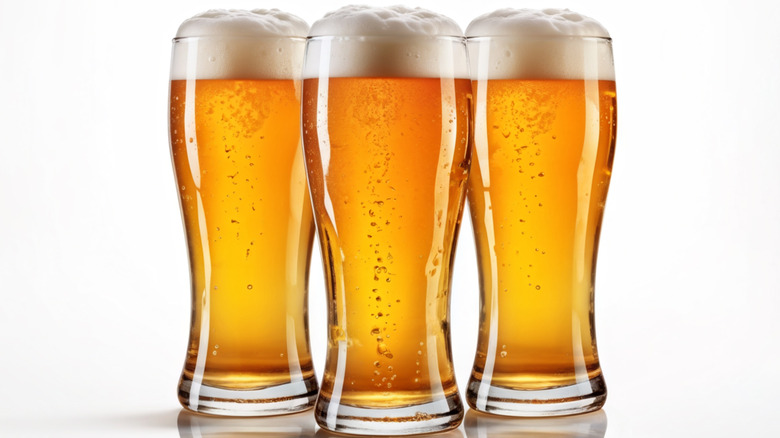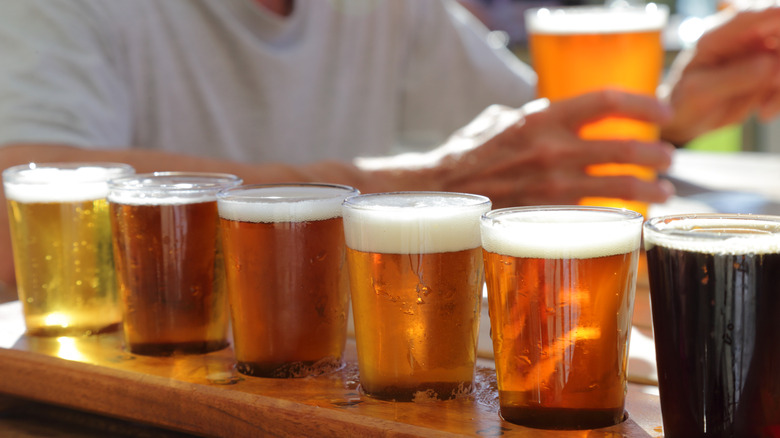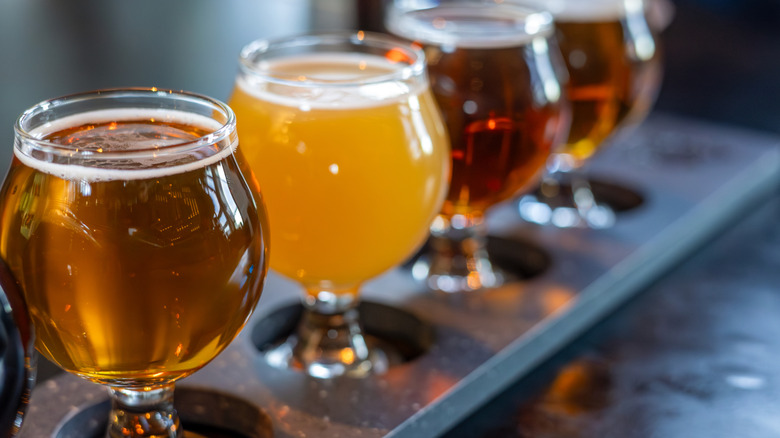How Much Of Your Average Beer Is Just Water?
One of the first things you learn when trying to brew beer at home — aside from how easy it is to make a colossal mess — is that beer is mostly water. Like, a lot of water. As many brewers have noted, what most people misunderstand about beer is that it contains anywhere from 80 to 90% water, which, in hindsight, explains why my ill-fated attempt at home brewing produced a result that was like murky and smelly pond water than anything resembling a crisp lager. Turns out, the quality of water used in brewing is just as important as the hops and malt, a fact borne out by my use of tap water.
While it's easy to think of beer as a hoppy, yeasty, or malty beverage, the reality is that water is the backbone of every brew, influencing everything from flavor to mouthfeel. It's no coincidence that some of the world's most famous breweries are located near pristine water sources, from the mineral-rich waters of Burton-on-Trent in England to the soft waters of Pilsen in the Czech Republic. Without good water, even the best ingredients won't save a brew.
The brewing process and why so much water is needed
Beer is made through a process that transforms barley, hops, yeast, and water into the frothy beverage we know and love. The water dissolves sugars from malted grains, extracts flavors from hops, and provides a hospitable environment for yeast fermentation. Specific water profiles are often what sets apart different beer styles, such as a farmhouse ale, from regular beer.
Historically, brewing beer was a way for ancient civilizations to safely consume water, since the fermentation process helped kill harmful bacteria otherwise present in every sip. Some of the earliest records of brewing date back thousands of years with evidence of beer production found in Mesopotamia, ancient China, and even Egyptian tombs. The process hasn't changed much, though today's brewers have the luxury of fine-tuning water chemistry to create everything from crisp pilsners to robust stouts.
The high water content of beer also explains why brewing is such a resource-heavy process. On average, it takes about seven barrels of water to produce just one barrel of beer. That's because water isn't just in the final product: It's used for everything from cleaning brewing equipment to maintaining proper temperatures during fermentation. Some breweries have taken steps to reduce water waste, but the reality is that beer is, at its core, a glorified water delivery system.
Water's role in beer's flavor and your favorite styles
If you've ever wondered why beer tastes different depending on where it's brewed, the answer lies in the water profile of the region. The different minerals that are found in water, like calcium, magnesium, and sulfates, affect everything from mouthfeel to bitterness, which is why some areas are historically known for specific beer styles.
Take pale lagers, for example. The soft water of Pilsen, Czech Republic, creates the clean, crisp finish that makes pilsners the gold standard of lagers. On the other hand, the hard, sulfate-heavy water of Burton-on-Trent in England helps create bitter, hop-forward ales, an essential characteristic of British IPAs. Even in modern brewing, water chemistry is meticulously adjusted to mimic these legendary brewing regions, ensuring consistency across global beer brands.
Ultimately, beer is about balance. Brewers spend just as much time adjusting water chemistry as they do perfecting their recipes, proving that even in a drink that's 80-90% water, every drop matters. So the next time you take a sip of your favorite brew, remember: You're drinking mostly water, but it's water with centuries of history, careful science, and a little bit of magic.


